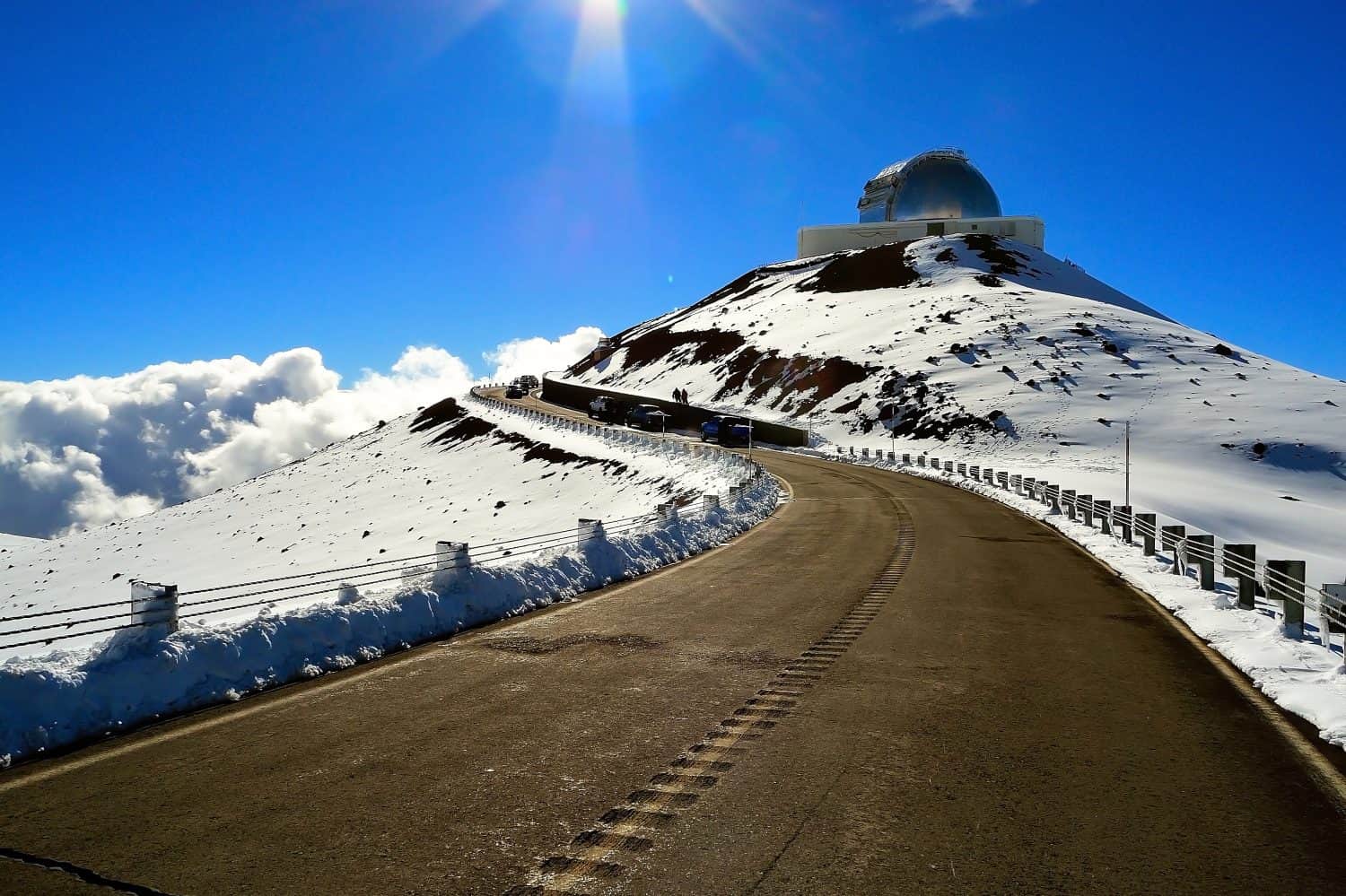When most people think of Hawaii, they envision warm, Pacific islands complete with palm trees, sun-soaked beaches, and an endless supply of beautiful, tropical flowers. But what about wintry weather? Does it ever snow in this island paradise? Yes, it snows in Hawaii. In fact, parts of Hawaii get significant amounts of snow every year. Snow typically falls in parts of Hawaii at elevations above 10,000 feet, but on rare occasions snow has fallen at much lower elevations.
Snow Falls in the Highest Mountains of Hawaii

The highest peaks of Hawaii get snow every year.
©LUC KOHNEN/Shutterstock.com
Most of Hawaii has a warm and temperate climate all year round. But Hawaii is not simply a land of beaches and plantations. Two massive volcanic mountains rise over the island of Hawai’i, also known as the Big Island. Mauna Kea, at 13,803 feet, and Mauna Loa, at 13,680 feet, stand the tallest. The third largest Hawaiian peak, Haleakalā, stands on the island of Maui, at 10, 023 feet.
When snow falls in Hawaii, it usually happens at elevations of at least 9,000 feet above sea level. Locations above 10,000 feet receive the bulk of wintry precipitation. Because the peaks of Mauna Kea and Mauna Loa stand well above 10,000 feet, they tend to get snow every year. Sometimes, these high mountain peaks receive several inches or even feet of snow. Haleakalā only gets snow every two to three years on average. Because it barely exceeds 10,000 feet, the amount of snow it receives also typically falls far short of that on the taller mountains.
Storm Systems Bring Heavy Precipitation

Several inches or even feet of snow can accumulate on Hawaii’s Mauna Kea summit.
©LUC KOHNEN/Shutterstock.com
On December 1, 2023, several inches of snow fell on Mauna Kea and Mauna Loa in Hawaii. This snow was brought on by a low pressure system known as a Kona, which blows in from the south or southwest, drawing moisture north across the islands.
Kona systems run opposite from the typical weather throughout the rest of the year. The usual tradewinds bring rain to the windward, or northeast sides of the islands, leaving the southwest leeward sides dry. When Kona systems arrive, they can bring high winds and torrential rains to the leeward sides of the islands, as well as blankets of snow in the higher elevations. These powerful storm systems can even bring tornadoes. Kona low systems most often occur in the winter, between December and March, when temperatures cool in Hawaii.
Record Snow in Hawaii
It is difficult to determine the precise amount of snow that falls on the peaks in Hawaii during heavy snowstorms. No one lives at the peaks of Mauna Loa and Mauna Kea, and the roads must close during snowstorms due to hazardous conditions. Therefore, record snow levels must be estimated.
The record amount of snowfall in Hawaii occurred at the top of Mauna Kea in 2016. Snowfall was estimated at more than 2 feet in s a snowstorm that began on December 1 that year. The next largest snowfall prior to that occurred in 1938, when a measured 6 inches of snow fell on Haleakalā.
Yes, You Can Ski in Hawaii
Technically, you can snow ski in Hawaii, though experts advise against it. The slopes are not marked, and rocks and other obstacles can pose great danger to skiers. The Hawaii Ski Club boasts a membership extending back to 1936, and in the past led organized trips to Hawaii’s peaks. However, organized ski trips to the peaks of Mauna Kea and Mauna Loa are now prohibited by law. The club now only arranges trips to the U.S. mainland and other locations such as Japan, New Zealand, Canada, and Europe.
How Long Does Snow Last in Hawaii?
Snow may fall year round on the cold peaks of Mauna Kea and Mauna Loa, but outside of the winter months it does not tend to last long. Within days any snow that reaches the ground will usually melt away. In the winter, when it gets colder on the mountains, more snow may accumulate and it may last for many weeks.
Does It Ever Snow at Lower Elevations?

Although it does not snow at lower elevations, residents of Hawaii can see the snowy peaks above.
©RobJ808/Shutterstock.com
Very rarely, snow has fallen at elevations as low as about 3,000 to 4,000 feet above sea level in Hawaii. Most of the residential and commercial areas on the islands lie below this level. Therefore, cities like Honolulu never get snow. But sometimes, residents of the Big Island can see the snow on the peaks of the mountains, and that makes for some pretty neat pictures.
When is Snow in Hawaii Most Likely?
As mentioned above, snow often accompanies the Kona systems that typically arrive from December to March. But snow on the highest peaks of Hawaii can happen in any month. Snow is most likely from October through April or May. Here is a summary of snow chances per season in Hawaii.
| Season | Snow Probability |
|---|---|
| Winter (December, January, and February) | Several inches to feet of snow throughout the season at elevations above 12,000 feet. |
| Spring (March, April, and May) | Some accumulations of snow possible above 12,000 feet through May. |
| Summer (June, July, and August) | Snow showers possible without accumulation. |
| Fall (September, October, and November) | Some snow accumulation above 12,000 feet beginning in October. |
The photo featured at the top of this post is © RobJ808/Shutterstock.com
